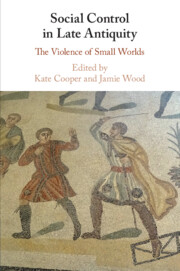Book contents
- Social Control in Late Antiquity
- Social Control in Late Antiquity
- Copyright page
- Contents
- Contributors
- Preface and Acknowledgements
- Abbreviations
- Introduction
- Part I Women and Children First
- Part II ‘Slaves, be subject to your masters’
- Part III Knowledge, Power, and Symbolic Violence
- Chapter 8 John Chrysostom and the Strategic Use of Fear
- Chapter 9 The Fear of Belonging
- Chapter 10 Words at War
- Chapter 11 Of Sojourners and Soldiers
- Chapter 12 Coercing the Catechists
- Part IV Vulnerability and Power
- Bibliography
- Index
Chapter 8 - John Chrysostom and the Strategic Use of Fear
from Part III - Knowledge, Power, and Symbolic Violence
Published online by Cambridge University Press: 18 September 2020
- Social Control in Late Antiquity
- Social Control in Late Antiquity
- Copyright page
- Contents
- Contributors
- Preface and Acknowledgements
- Abbreviations
- Introduction
- Part I Women and Children First
- Part II ‘Slaves, be subject to your masters’
- Part III Knowledge, Power, and Symbolic Violence
- Chapter 8 John Chrysostom and the Strategic Use of Fear
- Chapter 9 The Fear of Belonging
- Chapter 10 Words at War
- Chapter 11 Of Sojourners and Soldiers
- Chapter 12 Coercing the Catechists
- Part IV Vulnerability and Power
- Bibliography
- Index
Summary
The writings of John Chrysostom reveal a great interest in the emotion of fear and a deep appreciation for its utility in the service of ethical formation. He understood that through fear people could be restrained from doing wrong and goaded into doing right, and, to these ends, he favoured and promoted the telling of frightening stories. He also believed that a lively sense of fear could promote compassion for the misfortunes of others and strengthen group solidarity. But, above all, Chrysostom exploited the ‘deliberative aspect’ of fear: its ability to trigger reflection on the value of threatened goods and the proximity of apparent danger. By inciting fear, he called into question the value of material goods and drove home belief in the reality and immanence of the Last Judgement. Fear, in his writings, has thus not only a repressive, but also a creative – even imaginative – aspect.
Keywords
- Type
- Chapter
- Information
- Social Control in Late AntiquityThe Violence of Small Worlds, pp. 173 - 187Publisher: Cambridge University PressPrint publication year: 2020



